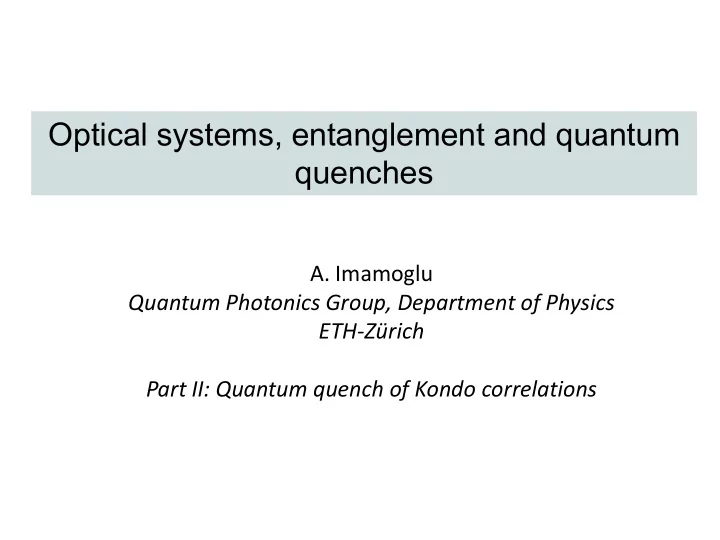

Optical systems, entanglement and quantum quenches A. Imamoglu Quantum Photonics Group, Department of Physics ETH-Zürich Part II: Quantum quench of Kondo correlations
Thanks to • Christian Latta • Florian Haupt • Wolf Wüster, Parisa Fallahi • Hakan Tureci (Princeton) • Leonid Glazman (Yale) • Markus Hanl, Andreas Weichselbaum, Jan von Delft (LMU Munich)
Confocal microscopy at low temperatures detected signal includes interference effect: QD susceptibility: scattered scattered back dispersive absorptive forward & reflected
Photoluminescence as a function of gate voltage reveals different charging states X 3- 15 nm, 4 K X 1- X 2- X 0 25nm
The influence on tunnel barrier width on QD photoluminescence 1.374 X 3- X 0 15 nm, 4 K X + 1.372 X 2+ emission energy (eV) X 3+ X - 1.370 X 1- X 2- 1.368 1.366 X 0 1.364 -10 -5 0 5 10 15 20 25 25nm gate voltage (mV) Signatures of strong tunnel coupling to fermionic reservoir (FR): Broad emission lines & spatially indirect transitions • By adjusting the tunnel barrier we can suppress or enhance tunnel coupling to the reservoir.
Optical probe of spin physics In some cases decoherence can be more interesting than coherent dynamics Γ Ω + Ω − 10 5 nuclear spins Hyperfine coupling to QD nuclear spins Exchange interactions with electrons in a fermi sea ⇨ Optical excitations as a probe of spin-reservoir coupling
Single electron charged QD+Fermionic reservoir An electron (magnetic impurity) in the proximity of a Fermi reservoir (FR) - Anderson Hamiltonian Quantum dot electron in local moment regime : Coupling is reduced to an effective spin-spin interaction virtual state Spin exchange Fermi sea QD electron electrons (anti - ferromagnetic)
Can we learn something new about Kondo effect using optical absorption ? • Competition between exchange coupling (leading to Kondo screening cloud) and Zeeman interaction should yield reduced magnetization: strong spin- polarization correlations allows us to measure magnetization from the area under the absorption curve. • The quench of Kondo correlations upon optical excitation (trion formation) modify the lineshape, leading to power-law tails.
Absorption lineshapes of a single electron charged QD Weakly coupled QD Strongly coupled QD • The asymmetry in the lineshape is partly due to an optical interference effect • Impossible to fit the strongly coupled QD with a perturbative lineshape
Absorption lineshapes of a single electron charged QD Weakly coupled QD Strongly coupled QD • The asymmetry in the lineshape is partly due to an optical interference effect • Impossible to fit the strongly coupled QD with a perturbative lineshape The lineshape depends strongly on gate voltage & hence the Kondo temperature: 1.3679 laser energy (eV) 1.3678 1.3677 1.3676 1.3675 -1.0 -0.5 0.0 ε /U
The influence on tunnel barrier width on a negatively charged QD absorption 1.3679 15 nm, 160 mK laser energy (eV) 1.3678 1.3677 1.3676 1.3675 -1.0 -0.5 0.0 gate voltage ( ε /U) 35nm, 4 K 1.3051 Signatures of strong tunnel/exchange laser energy (eV) coupling: • Asymmetric broadening at the edges • Lamb-shift of the ground-state 0.46 0.48 0.50 0.52 0.54 0.56 gate voltage (V)
The influence on tunnel barrier width on a negatively charged QD absorption 0.06 15 nm, 160 mK E F 0.04 Trions states G )/U uncoupled from FR i G -E 0.02 f (E E F 0.00 Renormalization of the experiment NRG ground state energy -1.0 -0.5 0.0 ε /U Signatures of strong tunnel/exchange From fit (NRG): coupling: • Asymmetric broadening at the edges • Lamb-shift of the ground-state
Perturbative regime: ν > T K 2D DOS: Bandwidth of states D in the Fermi sea which contribute is proportional to laser detuning Blue laser detuning 0 10 NRG Experiment -1 10 A( ν ) -2 10 -3 10 -4 -3 -2 -1 0 10 10 10 10 10 ν /U Red detuning: exponential tails which allow us to determine the electron temperature
Kondo strong coupling regime: Intitial state Final state Final state Absorption Evolution (Hole: only spectator) • Absorption process „turns off“ the interactions • Fermionic reservoir (FR) strongly modiefied: part of the system • Initial and final state FR are orthogonal Anderson orthogonality catastrophe (AOC)
Anderson orthogonality catastrophe: Consequence of quantum quench of Kondo correlations After absorption, system is not in an Eigenstate of Eigenstate No Eigenstate Absorption spectrum can be rewritten as: Kondo: power-law singularity with related to the phase shifts in the Fermi sea and could be determined using the (generalized) Hopfield rule
Experimental signatures of Kondo correlations: remarkable agreement with the theory • Power-law tails for ν < T K are smeared out by finite electron temperature!
How to determine the power law exponents? • By adjusting the (circular) polarization of the laser, we could address transitions from spin up (blue) or down (red) initial states. • The lineshapes are sensitive to the magnetic-field-tunable power-law exponents.
Suppression of magnetization • The area under the absorption lineshapes reveal that the magnetization of the QD is suppressed.
Summary and Outlook • Optical measurements allowed us to obtain signatures of quantum quench of Kondo correlations for the first time • The Anderson orthogonality catastrophe induced power law exponents can be tuned by changing the magnetic field • Use QD nuclear spin relaxation to monitor Kondo correlations • Photon correlations can be used to monitor time- evolution following the quench.
Recommend
More recommend